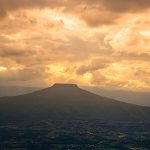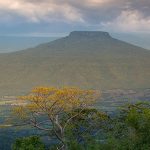
When tourists feel they’ve luxuriated for long enough on the kingdom’s idyll islands and stunning beaches, they often travel north for a taste of the Thai hills. Most follow the wel-trodden route to Chiang Mai, a city famous for its forested misty peaks and Lanna culture. But to enjoy a less well-known Thai gem, that’s equally abundant in natural wonders, you’re well advised to head northeast and explore the happy green hills of Loei.
Loei, some 500 kilometres from Bangkok, boasts attractions that easily rival those of its northerly neighbours, Chiang Mai and Chiang Rai, but with an added Isan twist. There are similar emerald-green hills and vibrant festivals, but also fiery salads and rich curries to enjoy, washed down with famous local coffee.
Thai travellers come here to hike during the cool season when temperatures can drop to zero at night. Phu Kradeung offers the most popular excursions, and a trek to its wide plateau takes a few hours up steep trails and through the ghostly pine forests. It’s a rite of passage for young people visiting the region and the dawn views are spectacular.
But you don’t have to be super-fit and camping-equipped to enjoy the natural wonders of this province. Just take a few day trips to discover Loei’s secrets and you’ll soon understand why the region is considered to be the gem of Thailand’s Northeast.
Start with the hills. From a good vantage point on a sunny day, you see them stretch out for miles in every direction, threaded with silver streams and rivers and dappled by shadows from the clouds. But there’s one peak that stands out, not for its size but for its shape: this is Phu Ho.
Somebody once noticed that Phu Ho resembled Japan’s famous Mount Fuji with its distinctive slopes, and people have been coming to look ever since. There certainly is a distinct resemblance to Japan’s most famous mountain, but 900-metre Phu Ho boasts lush tropical green, from its base on the plains, to its often-misty summit.
People rarely climb Phu Ho itself, most view it from adjacent Phu Pa Po. And it’s a stunning sight. You can enjoy such a wide panorama that you can see sunlight pouring onto the mountain from one side while the clouds are bursting open with rain on the other. This is a view that’s spectacular whatever time of day or year you’re there. At times the flat-topped peak seems to be floating on an undulating sea of fog. But try to visit Phu Ho at dawn or sunset, as the skies all around you erupt into a technicolour tapestry of light.
There are views left and right to enjoy as Phu Pa Po is a conservation area and filled with wildflowers, trees and meadows. And, when your driver turns off his engine, the silence overwhelms you. Other than the buzz of an occasional insect there is perfect peace. It’s an eerie and sublime experience for anyone whose experiences of Thailand are the ever-noisy streets of Bangkok.
There are several stops up Phu Pa Po to see the views and take in the Phu Ho panorama, but the final one involves a couple of hundred metres of hill climbing on foot before you arrive panting at the top.
So, catch your breath and take a look around. As well as the distinctive Phu Ho, you can see the long flat plateau of Phu Kradeung – it’s another peak to conquer, so make plans to be back here in the cool season when this lush and lovely province puts on its winter plumage and takes on a different character. The happy hills of Loei are always enticing. You’ll be back.
Getting there:
- Plane: Nok Air and Air Asia offer daily flights to Loei Airport.
- Train: Loei is not serviced by rail, but you can take a train to Udon Thani (150 km east) and take local buses.
- Bus: Buses leave Bangkok’s Northern Bus Terminal (Mochit 2 Bus Terminal) to Loei every day between 08.30 Hrs. and 22.00 Hrs.
Best time to visit
Loei is pleasant at any time of year, but the most popular time to hike tends to be mid-October to February when temperatures drop.











